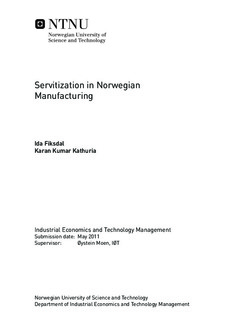| dc.contributor.advisor | Moen, Øystein | nb_NO |
| dc.contributor.author | Fiksdal, Ida | nb_NO |
| dc.contributor.author | Kathuria, Karan Kumar | nb_NO |
| dc.date.accessioned | 2014-12-19T14:27:59Z | |
| dc.date.available | 2014-12-19T14:27:59Z | |
| dc.date.created | 2012-03-04 | nb_NO |
| dc.date.issued | 2011 | nb_NO |
| dc.identifier | 507345 | nb_NO |
| dc.identifier | ntnudaim:5990 | nb_NO |
| dc.identifier.uri | http://hdl.handle.net/11250/266033 | |
| dc.description.abstract | Norwegian manufacturers are experiencing increasing competition from manufactures based in developing countries with substantially lower production costs. This increased competition forces manufacturers to differentiate and add more value to their offerings, in order to stay competitive. Servitization represents a strategy for Norwegian manufacturers to do so by expanding their business model to include services and ultimately provide solutions. Despite the evolvement of different servitization strategies among Norwegian manufacturers, the concept has yet to be properly studied in this context. On the basis of a multiple case study, this paper aims to identify why servitization is attractive for Norwegian manufacturers and how the strategy should be implemented. A comprehensive literature study including 26 empirical articles and 20 conceptual articles was initially conducted to provide a theoretical foundation for study. Following this, five suitable Norwegian manufacturing companies were selected as case companies. Data was collected largely by interviewing managers from the five manufacturing companies, and subsequently analysed in relation to the theoretical foundation. The study finds that servitization is attractive for Norwegian manufacturers because the strategy ensures a good alignment between the offerings and the comparative advantages of the companies, and because customers value it. Manufacturers that decide to servitize should put great emphasis on the transition required to become a servitized manufacturer. The new resources that must be developed in order to succeed with a servitization strategy, coupled with cultural and structural rigidnesses, make the required transition more problematic than companies expect. Companies pursuing a new strategy to increase competitiveness cannot, like Resource-advantage theory of competition states, purely rely on its current comparative advantages to find it. In order to do so, they must also critically consider their ability to change and adapt to the new strategies proposed. Servitization is an attractive strategy for Norwegian manufacturers considering their comparative advantages, but when bearing in mind the dynamic capabilities required to implement it, the strategy becomes less apparent. | nb_NO |
| dc.language | eng | nb_NO |
| dc.publisher | Institutt for industriell økonomi og teknologiledelse | nb_NO |
| dc.subject | ntnudaim:5990 | no_NO |
| dc.subject | MTIØT Industriell økonomi og teknologiledelse | no_NO |
| dc.subject | | no_NO |
| dc.subject | Strategi og internasjonal forretnmingsutvikling | no_NO |
| dc.title | Servitization in Norwegian Manufacturing | nb_NO |
| dc.type | Master thesis | nb_NO |
| dc.source.pagenumber | 150 | nb_NO |
| dc.contributor.department | Norges teknisk-naturvitenskapelige universitet, Fakultet for samfunnsvitenskap og teknologiledelse, Institutt for industriell økonomi og teknologiledelse | nb_NO |

